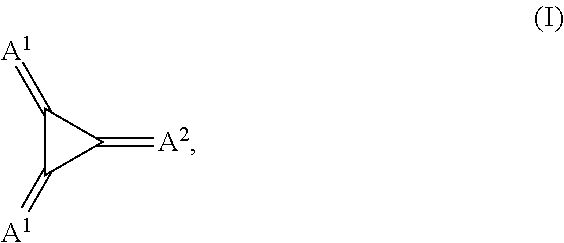Substituted 1,2,3-Triylidenetris(cyanomethanylylidene) Cyclopropanes for VTE, Electronic Devices and Semiconducting Materials Using Them
a technology of cyanomethane and cyclopropane, which is applied in the field of substituted 1,2,3-triylidenetris (cyanomethane)) cyclopropane with aryl or heteroaryl groups, can solve the problem that the thermal stability of state-of-the-art dopants is often key limitation for the duration, and achieves high yield and/or purity.
- Summary
- Abstract
- Description
- Claims
- Application Information
AI Technical Summary
Benefits of technology
Problems solved by technology
Method used
Image
Examples
synthesis examples
[0048]Syntheses of symmetric compounds are based on procedures described in U.S. Pat. No. 8,057,712 and application EP 13176542.
[0049]Syntheses of asymmetrically substituted derivatives are based on procedures described in U.S. Pat. No. 3,963,769 and in J. Am. Chem. Soc. 1976, volume 98, p. 610-611.
Betaine Precursors
Betaine C2-B
[0050]A 500 mL Schlenk flask was charged with tetrachlorocyclopropene (8.30 g, 46.7 mmol) and 2-(4-cyano-2,3,5,6-tetrafluorophenyl)acetonitrile (C2-A, 20.0 g, 93.4 mmol) and dry dichloromethane (DCM, 160 mL) were added. The mixture was stirred and cooled to −30° C. and triethyl amine (30.7 g, 304 mmol) was added dropwise over 30 min. The mixture was allowed to warm to room temperature over 1 h. Water (24 mL) was added dropwise and the mixture was filtered. The solid was washed with DCM (3×50 mL), MeOH (2×50 mL) and water (4×50 mL) and dried in vacuum to give 28 g of crude product. Recrystallization from acetonitrile afforded the product as a yellow solid (19 ...
PUM
| Property | Measurement | Unit |
|---|---|---|
| temperature | aaaaa | aaaaa |
| pressure | aaaaa | aaaaa |
| temperatures | aaaaa | aaaaa |
Abstract
Description
Claims
Application Information
 Login to View More
Login to View More - R&D
- Intellectual Property
- Life Sciences
- Materials
- Tech Scout
- Unparalleled Data Quality
- Higher Quality Content
- 60% Fewer Hallucinations
Browse by: Latest US Patents, China's latest patents, Technical Efficacy Thesaurus, Application Domain, Technology Topic, Popular Technical Reports.
© 2025 PatSnap. All rights reserved.Legal|Privacy policy|Modern Slavery Act Transparency Statement|Sitemap|About US| Contact US: help@patsnap.com



